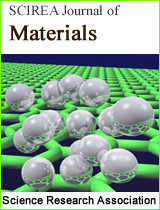Electrospun silver modified polyarylonitrile-activated carbon composite fibers: Methylene blue adsorption and antibacterial activity
DOI: 341 Downloads 16150 Views
Author(s)
Abstract
Silver modified polyacrylonitrile-activated carbon (Ag-PAN-AC) composite fibers containing various AC concentrations were prepared by using an electrospinning process. Ag-PAN nanoparticles were initially prepared via in-situ reduction of silver nitrate using hydrazinium hydroxide as a reducing agent. The influence of AC contents on fiber morphology, methylene blue (MB) adsorption and antibacterial activity were investigated. Ag-PAN-AC composite fibers had rough and porous surfaces with an average fiber diameter of 200-250 nm. The size of fibers slightly decreased with increasing bead fibers when the dosage of AC increased. The Ag-PAN-AC composite fibers containing 5% (w/v) of AC showed the maximum MB adsorption and exhibited the highest antibacterial activity against Staphylococcus aureus (S. aureus) due to the synergetic effect of AC and large surface area of fibers. The MB adsorption isotherm was Langmuir isotherm and the kinetic data fitted well with the pseudo second order model. The obtained results suggested that Ag-PAN-AC composite fibers could be promising candidates as dye adsorbents with antibacterial activity.
Keywords
polyacrylonitrile, activated carbon, silver nanoparticle, composite fiber, electrospinning
Cite this paper
Thinnakorn Magdee, Darunee Aussawasathien, Sa-Nguansak Sriphalang, Kittipong Hrimchum,
Electrospun silver modified polyarylonitrile-activated carbon composite fibers: Methylene blue adsorption and antibacterial activity
, SCIREA Journal of Materials.
Volume 3, Issue 2, April 2018 | PP. 58-75.
References
| [ 1 ] | Bhardwaj N & Kundu S C, Biotech Adv, 28 (2010) 325-347. |
| [ 2 ] | Deitzel J M, Kleinmeyer J, Harris D & Tan N C B, Polymer, 42 (2001) 261-272. |
| [ 3 ] | Megelski S, Stephens J S, Chase D B & Rabolt J F, Macromolecules, 35 (2002) 8456-8466. |
| [ 4 ] | Fong H, Chun I & Reneker D H, Polymer, 40 (1999) 4585-4592. |
| [ 5 ] | Zong X, Kim K, Fang D, Ran S, Hsiao B S & Chu B, Polymer, 43 (2002) 4403-4412. |
| [ 6 ] | Aussawasathien D, Sahasithiwat S, Menbangpung L & Teerawattananon C, Sensor Actuat B-Chem, 151 (2011) 341-350. |
| [ 7 ] | Yoshimoto H, Shin Y M, Terai H & Vacanti J P, Biomaterials, 24 (2003) 2077-2082. |
| [ 8 ] | Khil M S, Cha D I, Kim H Y, Kim I S & Bhattarai N J, J Biomed Mater Res B: Appl Biomater, 67B (2003) 675-679. |
| [ 9 ] | Aussawasathien D, Teerawattananon C & Vongachariya A, J Membr Sci, 315 (2008) 11-19. |
| [ 10 ] | Bergshoef M M & Vancso G J, Adv Mater, 11 (1999) 1362-1365. |
| [ 11 ] | Rai M, Yadav A & Gade A, Biotechnol Adv, 27 (2009) 76-83. |
| [ 12 ] | Rujitanaroj P, Pimpha N & Supaphol P, Polymer, 49 (2008) 4723-4732. |
| [ 13 ] | Xing Z-C, Chae W-P, Baek J-Y, Choi M-J, Jung Y & Kang I-K, Biomacromolecules, 11 (2010) 1248-1253. |
| [ 14 ] | Park S-W, Bae H-S, Xing Z-C, Kwon O H, Huh M-W. & Kang I-K, J Appl Polym Sci, 112 (2009) 2320-2326. |
| [ 15 ] | Yang Q B, Li D M, Hong Y L, Li Z Y, Wang C, Qiu S L & Wei Y, Synth Met, 137 (2003) 973-974. |
| [ 16 ] | Luong N D, Lee Y & Nam J-D, Eur Polym J, 44 (2008) 3116-3121. |
| [ 17 ] | Singh C K, Sahu J N, Mahalik K K, Mohanty C R, Mohan B R and Meikap B C, J Hazard Mater, 153 (2008) 221-228. |
| [ 18 ] | Hesas R H, Arami-Niya A, Daud W M A W & Sahu J N, BioRes, 8 (2013) 2950-2966. |
| [ 19 ] | Hameed B H, Din A T M & Ahmad A L, J Hazard Mater, 141 (2007) 819-825. |
| [ 20 ] | Zhao R, Wang Y, Li X, Sun B, Jiang Z & Wang C, Colloid Surface B, 136 (2015) 375-382. |
| [ 21 ] | Senthilkumaar S, Varadarajan P R, Orkodi K & Subbhuraam C V, J Colloid Interface Sci, 284 (2005) 78-82. |
| [ 22 ] | Royer B, Cardoso N F, Lima E C, Vaghetti J C P, Simon N M, Calvete T & Veses R C, J Hazard Mater, 164 (2009) 1213-1222. |
| [ 23 ] | Han R, Zhang J, Han P, Wang Y, Zhao Z & Tang M, Chem Eng J, 145 (2009) 496-504. |
| [ 24 ] | Pripdeevech P & Saansoomchai J, Chiang Mai J Sci, 40 (2013) 214-223. |
| [ 25 ] | Larrondo L & St. John Manley R, J Polym Sci B Polym Phys Ed, 19 (1981) 909-920. |
| [ 26 ] | Lee J S, Choi K H, Ghim H D, Kim S S, Chun D H, Kim H Y & Lyoo W S, J. Appl. Polym. Sci, 93 (2004) 1638-1646. |
| [ 27 ] | Ra E J, An K H, Kim K K, Jeong S Y & Lee YH, Chem Phys Lett, 413 (2005) 188-193. |
| [ 28 ] | Hameed B H, Tan I A W & Ahmad A L, Chem. Eng. J, 144 (2008) 235-244. |
| [ 29 ] | Weber T W & Chakkravorti R K, AiChE. J, 20 (1974) 228-238. |
| [ 30 ] | Aluigi A, Rombaldoni F, Tonetti C & Jannoke L, J Hazard Mater, 268 (2014) 156-165. |
| [ 31 ] | Wei D W, Sun W Y, Qian W P, Ye Y Z & Ma X Y, Carbohydr Res, 344 (2009) 2375-2382. |
| [ 32 ] | An J, Zhang H, Zhang J, Zhao Y H & Yuan X Y, Colloid Polym. Sci, 287 (2009) 1425-1434. |

